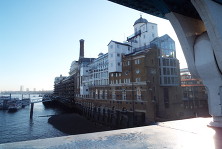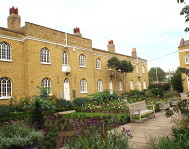








The Herb Garden, Southwark Cathedral
The herb garden at the eastern end of Southwark Cathedral was inspired by the medieval St Thomas’ Hospital that was once a part of the priory of St Mary Overie (now Southwark Cathedral). It was created as part of Southwark Cathedral’s Millennium Project, a £10 million project that included cleaning and restoration of the Cathedral, a new library, exhibition centre and restaurant. Partly funded by the Millennium Commission, it was part of the regeneration that Bankside in Southwark underwent in the late nineteen nineties. The project also included the renovation of the Cathedral garden.
delay. It remained until 1830 when it was taken down to make way for the building of an approach road to the new London Bridge that was in the process of construction a little way to the west of the former medieval bridge and closer to the Cathedral. The effigy of Bishop Andrewes was removed to the South Aisle within the main building.
Returning to the millennium renovations to the Cathedral garden, the herb garden was created incorporating the stone foundations of the Lady Chapel. The planting was carried out by Walworth Garden Farm using healing herbs that would have been used by the medieval apothecaries of St Thomas’ Hospital. The Cathedral was officially "reopened" by Nelson Mandela in April 2001 on completion of the Cathedral's refurbishment.
The site where the herb garden was created was not then accessible to the public. The designers decided to clear and level the area but in doing so the foundations of the medieval Lady Chapel were revealed. The Lady Chapel had been converted into a crypt in the 17th century to accommodate the remains of Bishop Lancelot Andrewes who died in 1626 and became known as the Bishop’s Chapel. Renovations to the Cathedral (then known as St Saviour’s Church) were undertaken in 1818 to 1824 and the architect George Gwilt felt the Bishop’s Chapel was in such a ruinous and precarious condition that demolition should be undertaken without
An illustration showing the Cathedral and, to the left, the original Lady Chapel / Bishop's Chapel before it was demolished.
Web discoveries
- UK Casino Not On Gamstop
- UK Casino Not On Gamstop
- Non Gamstop Casino
- Casinos Not On Gamstop
- Non Gamstop Casinos
- Non Gamstop Casinos
- Non Gamstop Casino
- Casino Sites Not On Gamstop
- Slots Not On Gamstop
- Casinos Not On Gamstop
- UK Betting Sites Not On Gamstop
- UK Casino Not On Gamstop
- Best Non Gamstop Casinos
- Betting Sites
- Non Gamstop Casino Sites UK
- Best Non Gamstop Casinos
- Non Gamstop Casino
- Casinos Not On Gamstop
- Non Gamstop Casino Sites UK